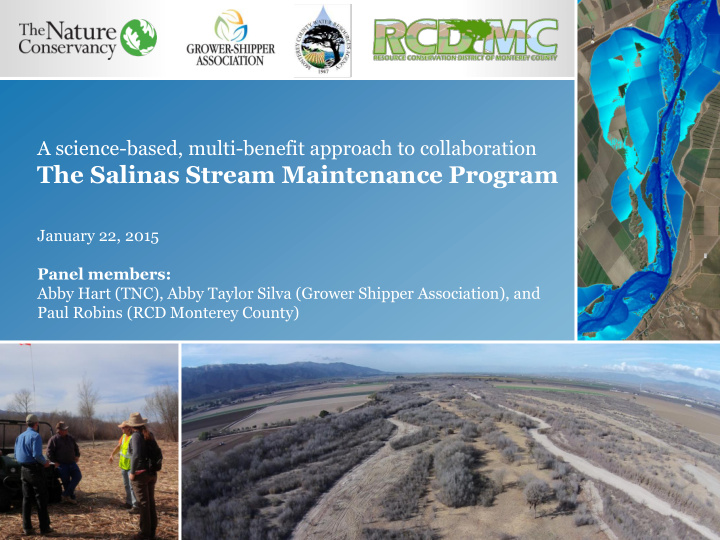



A science-based, multi-benefit approach to collaboration The Salinas Stream Maintenance Program January 22, 2015 Panel members: Abby Hart (TNC), Abby Taylor Silva (Grower Shipper Association), and Paul Robins (RCD Monterey County)
Context • 100+ miles long • 4600 square miles • $4.5 Billion agriculture industry in Monterey County alone: vegetables, berries, grapes… • Sensitive species: • Steelhead trout • CA red-legged frog • Least Bell’s vireo • Western snowy plover
History of the SMP 1995-2008 – Management for flood risk • reduction in response to 1995 flood. Administered by MCWRA which held the 404 and 401 permits. Landowners obtained their own 1600 permits for maintenance activities. • 2008 – Potential impacts to threatened species and the river system halt the SMP • 2008-2014 – Stakeholders at odds over management approaches
Interim solution - Arundo control with RCD • 1400 acres infested by arundo mapped along the river • Extent and density of infestation likely to increase with year-round water • Degrades quality of habitat and worsens flood risk • Resource agencies’ goals aligned with landowners’
Arundo control with the RCD • Top-to-bottom of watershed treatment • SLO County infestations under management • Upstream of King City treated once • Minimize environmental impacts and focus on positive benefits of control • Environmental permitting 2011-2014 • Pursuing funding to augment landowner efforts. • CA Wildlife Conservation Board $1.1 M Aug 2014
Ideal arundo treatment Treat Reduce Treated area Revegetate (when appropriate)
Demonstrating a new approach to stream maintenance • TNC began having conversations with landowners in 2013, together with GSA, Salinas River Channel Coalition, RCD, Water Resources Agency, landowners, and others • Start back at the drawing board • Build the relationships • Develop the science • Jointly design a new approach that would provide multiple benefits
Science-based approach • Altered river system • Reservoirs, dams, levees, Salinas Valley Water Project, etc. • New 2-d, hydraulic model Diagnose the problems • • Better define benefits to whole system • Better define potential impacts to individual species (aquatic and terrestrial)
Multi-benefit approach Stakeholder interests • Reduce flood risk • Improve quality and diversity of the ecological system • Prevent erosion • Facilitate steelhead trout migration to and from Arroyo Seco River • Improve water quality The starting point: Use science to show where these goals align or overlap
Scientific foundation The 2D hydraulic model • Modeled frequent flow scenarios • 2, 5, and 10-year return flow events • Modeled “bookend” management scenarios to understand range of possible benefits and impacts • Bookend 1 – Total clearing of vegetation in the river channel • Bookend 2 – No clearing, current river conditions • Modeled proposed scenarios based on stakeholder goals and multi-benefit approach
Scientific foundation The 2D hydraulic model 5 and 10 year return flow events https://www.youtube.com/watch?v=2vow6b8VEq0
Scientific foundation The 2D hydraulic model 5 and 10 year return flow events https://www.youtube.com/watch?v=2vow6b8VEq0
Scientific foundation Designing the secondary channels • Mimic the natural braiding of a sand-based system • Rebuild some of the historical structure and function of the river Meander cutoffs Low-lying areas with natural vegetation Former river alignments
Scientific foundation Designing the secondary channels
Scientific foundation Visualizing the benefits
Demonstrating the approach Building on partnerships • Conduct site visits and meet regularly with project stakeholders • Engage landowners at every step • Technical and Design Committees • Permitting Committee • Iterative, collaborative approach
Demonstrating the approach Phase I – Chualar and Gonzales RMUs • Spring 2014 – Submit permit application for demonstration project along 11 miles of the river in Chualar and Gonzales River Management Units (RMU) • Fall 2014 – Work begins at the demonstration site • Fall 2015 – Second year of work begins
Expanding the approach Phase II – Hwy 1 to San Ardo • Revised the model to assess flows across a much larger portion of the river • Defined RMUs for the rest of the program area • Worked with landowners to design maintenance areas through Technical & Design Committee • Permitting Committee prepared materials for the permitting agencies, hosted a field visit and reviewed permit application
Expanding the approach Next Steps • Ongoing engagement with permitting committees • Prepare for work to begin in the fall of 2016
Thank you! Contact info: • Abby Hart (abigail.hart@tnc.org) • Abby Taylor-Silva (abby@growershipper.com) • Paul Robins (paul.robins@rcdmonterey.org) • Shaunna Juarez (juarezsl@co.monterey.ca.us)
Recommend
More recommend